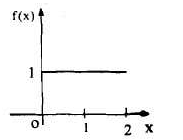UNIT-2
Q1:
Using complex form,find the Fourier series of the function
f(x) = signx = 
solution:
we calculate the coefficients 




 =
= 
=
Hence the Fourier series of the function in complex form is

We can transform the series and write it in the real form by renaming as
n=2k-1,n=


= 
Q2:
Using complex form find the Fourier series of the function f(x) = x2, defined on te interval [-1,1]
Solution:
Here the half-period is L=1.Therefore,the co-efficient c0 is,

For n

Integrating by parts twice,we obtain

= 
= 
=  .
.
=  .
.
Q3
Find the fourier integral representation of the function

Solution:
The graph of the function is shown in the below figure satisfies the hypothesis of
Theorem -1 . Hence from Eqn,(5) and (6), we have





Substituting these coefficients in Eqn.(4) we obtain




This is the Fourier integral representation of the given function.
Q 4:
Find the Fourier integral representation of the function

Solution:
The graph of the given function is shown in the below figure . Clearly, the given function f(x) is an even function. We represent f(x) by the fourier cosine integral . We obtain




And thus ,

Q 5:
Find the Fourier cosine integral of  , where x>0, k>0 hence show that
, where x>0, k>0 hence show that

Solution:
The Fourier cosine integral of f(x) is given by:





Q 6:
Find the half –range sine series of the function

Solution:


Where





Q7:
Fourier sine integral for even function f(x):

Solution:

 is a Fourier sine transform of f(x)
is a Fourier sine transform of f(x)
 is a Inverse Fourier sine transformation of FC(x)
is a Inverse Fourier sine transformation of FC(x)
Q 8:Fourier cosine integral for even function f(x):

Solution:

 Fourier cosine transform of f(x)
Fourier cosine transform of f(x)
 ...Inverse Fourier cosine transform of Fc(x).
...Inverse Fourier cosine transform of Fc(x).
Q 9:
Fourier cosine and sine transforms

Consider,
 =
=

Q 10:
Fourier cosine transformation of the exponential function:
F(x)= ex
Solution:
Given,
F(x)= ex
From the know formula we directly apply,

Q 11:
Find the z-transformation of the following left-sided sequence

Solution:

= 
= 1- 
= 
If 
Q 12:

Solution:
Long division method to obtain 
 2
2





Now x(z) can be written as,
X(z) = 2-
Q 13:
Solve the differential equation  by z-transformation method.
by z-transformation method.
Solution:
Given,

Let y(z) be the z-transform of 
Taking z-transforms of both sides of eq(1) we get,

ie. 
using the given condition ,it reduces to
(z+1)y(z) = 
Ie.
Y(z) = 
Or Y(Z) = 
On taking inverse Z-transforms, we obtain

Q 14:
Solve  using z-transforms
using z-transforms
Solution:
Consider,

Taking z-transforms on both sides, we get
 =
=

 or
or

Now,



Using inverse z-transform we obtain,
